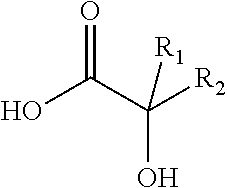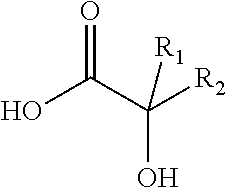Antiviral compositions and methods for inactivating non-enveloped viruses using alkyl 2-hydroxycarboxylic acids
a technology of alkyl 2hydroxycarboxylic acid and composition, which is applied in the direction of anhydride/acid/halide active ingredients, surface-active detergent compositions, biocide, etc., can solve the problems of frequent outbreaks of gastroenteritis among passengers and crew members on cruise ships and naval vessels, undesirable use of formaldehyde, and high antiviral efficacy, rapid cleaning and disinfection of surfaces
- Summary
- Abstract
- Description
- Claims
- Application Information
AI Technical Summary
Benefits of technology
Problems solved by technology
Method used
Image
Examples
examples
Compositions according to the invention were prepared and tested using a standard plaque Assay Protocol per below with murine Norovirus (MNV-1).
Plaque Assay Protocol
[0181]1. Pass cells according to Tissue Culture Protocols.[0182]2. Use hemocytometer to count cells and adjust suspension to 1×106 cells / ml.[0183]3. “Prepare cell culture plates by adding 2 ml of the cell suspension to each well in a six well plate. Rock plates gently to evenly distribute cells and incubate overnight.[0184]4. Perform the suspension assay. Ensure each dilution tube contains 1.8 ml media.[0185]5. Prepare 10 fold dilutions by adding 0.2 ml test substance / virus to dilution tubes containing 1.8 ml media.[0186]6. Aspirate media from cell culture plates (do not to let the cells over dry-only do a set of six plates at a time).[0187]7. Inoculate the six well plates with 500 uL of diluted virus per well in duplicates according to dilutions indicated below:[0188]8. Incubate plates for 1 hour at room temperature.[01...
PUM
| Property | Measurement | Unit |
|---|---|---|
| weight percent | aaaaa | aaaaa |
| weight percent | aaaaa | aaaaa |
| temperatures | aaaaa | aaaaa |
Abstract
Description
Claims
Application Information
 Login to View More
Login to View More - R&D
- Intellectual Property
- Life Sciences
- Materials
- Tech Scout
- Unparalleled Data Quality
- Higher Quality Content
- 60% Fewer Hallucinations
Browse by: Latest US Patents, China's latest patents, Technical Efficacy Thesaurus, Application Domain, Technology Topic, Popular Technical Reports.
© 2025 PatSnap. All rights reserved.Legal|Privacy policy|Modern Slavery Act Transparency Statement|Sitemap|About US| Contact US: help@patsnap.com



